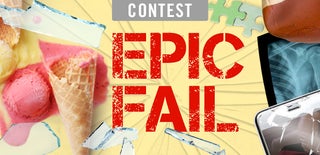Introduction: Pancake Art: What NOT to Do
I’ve attempted pancake art with my niece a dozen or so times now. We’re pretty good at making pancakes now, but we experienced many failures along our journey to pancake greatness. Who knew there were so many ways to ruin a pancake.
Step 1: The Lumps
Flour and pancake mix has a tendency to clump up. Normally, these small lumps aren’t a problem because the batter isn't being squeezed through a tiny hole.
But, the openings on the tips of squeeze bottles are quite small. If you don’t sift your flour, you’ll probably start off fine. Everything will be going well and then your fun will suddenly come to a halt. The tip of the bottle will become clogged with a lump of flour and the batter won’t be able to escape. You’ll think to yourself, well maybe if a squeeze a little bit harder I’ll be able to push it out. Squeeze hard enough and the entire top of the bottle will pop off, batter will cascade onto the griddle, ruining your masterpiece.
If you happen to get clogged, don’t squeeze. Sticking a toothpick up through the opening will break up the blockage and unclog the bottle. But, there will most likely be another evil lump that comes to stop you. Making pancakes with a case of the lumps is not a pleasant experience.
Step 2: Squeeze Bottle Volcano
One time we mixed, colored, and bottled our batter. Then, we decided to do a little bit of kitchen cleanup before we started the cooking process. Midway through cleaning one of the bottles erupted like a volcano. The cover popped off and the batter started oozing out like lava.
Similarly, if you want batter to flow out everywhere, try mixing all of the ingredients directly in a squeeze bottle. Pour all of the ingredients in and shake. When you take the lid off, batter will ooze out.
If you’re going to let your batter sit or if you plan on mixing everything in the bottle, only fill the bottle ¾ of the way so that everything doesn't ooze out. Otherwise, I recommend mixing the batter in a bowl and then using a funnel to transfer it into the bottles.
Step 3: Too Much Water
We’ve found that the easiest way to make pancake art is to create the outline first and then fill in the colored sections like a coloring book. But this won’t work if your batter is too watery. Too much water will cause the batter to run all over the place. Colors will mix and your image will be distorted.
I don’t know what the optimal viscosity is for pancake batter, but I do know that if you hold your bottle upside down and the batter just keeps flowing out, it’s definitely too thin. When you flip your bottle, the batter should drip out slowly.
Step 4: Squeezing
Don’t squeeze the bottle too hard. If squeeze too hard the thick batter might curl and twist as it comes out. So if your lines come out squiggly, try thinning out the batter with water or just apply less pressure as you squeeze.
Step 5: Too Much Heat
In the very beginning, I thought pancake art would be quick and simple, just like making regular pancakes. I was wrong. I started off with the griddle on medium heat. As I squeezed out the batter it sizzled and bubbled as it hit the griddle. All seemed well until I flipped the pancake over and saw that the colors were toasted brown. Not only did the pancake come out with an ugly brown tint, I was the one making all of the pancakes because the griddle was too hot for my niece to handle.
I recommend starting off with NO HEAT. Create the outline, then fill everything. Turn the heat on LAST. This way you won’t have to worry about burning anyone/anything. For the heat, use the lowest setting and let your pancake cook slowly so that you don’t brown your colors.
Step 6: Premature Flipping
Your pancake is cooking, it smells delicious, you’ve been waiting for what seems like hours and you just want to flip it already! But wait! If you flip the pancake too early it won’t survive. It might stick, rip, or tear, ruining all of your hard work.
So how do you know when the pancake is ready to flip? Look for the bubbles. The bubbles will start forming around the perimeter of the pancake and then they’ll work their way inward. So, wait for the bubbles to form in the center of the pancake. The bubbles in the center will start to pop, creating little craters, then the surface will start to dry up. When you see these signs, it’s time to flip.
If you ever attempt pancake art, try not to make the same mistakes we did!

Grand Prize in the
Spectacular Failures Contest













